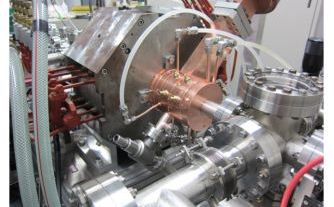show advanced search
-
141-160 / 290
- display number
-
order by date
-
order by researcher's name
-
order by affiliation
2015-0303-08
Frontier
Nanotechnology / Materials
posted:2015/03/03
極短電子線パルス発生装置
SAKAUE, Kazuyuki Researcher (Affiliated organization Waseda Institute for Advanced Study) (retired)
collaborative researchers:浦川 順治 教授 (retired), 黒田 主任研究員 (retired)
・高品質・極短電子線パルスを電子銃単体にて発生・高周波加速による小型かつ超高圧電子線の実現
2015-0303-07
Nanotechnology / Materials
posted:2015/03/03
Ultra-low-loss Tapered Optical Fibers(TOFs) and Ultra-high-Q Microtoroidal Resonators
AOKI, Takao Professor (Faculty of Science and Engineering School of Advanced Science and Engineering)
・The highest transmission measured for TOFs with an optimal shape is in excess of 99.7% with a total TOF length of only 23mm・Microtoroidal resonators to build on-chip cavity QED systems with very high quality factors
2015-0303-06
Nanotechnology / Materials
posted:2015/03/03
Self-healing Metal Wire for Stretchable Devices
IWASE, Eiji Professor (Faculty of Science and Engineering School of Fundamental Science and Engineering)
collaborative researchers:古志 知也
・High conductivity, and high stretchability for electric wire・Selective healing of a crack on a wire by “self-healing”function
2015-0303-05
Nanotechnology / Materials
posted:2015/03/03
Micro/Nano Device
SHOJI, Shuichi Professor (Faculty of Science and Engineering School of Fundamental Science and Engineering Department of Electronic and Photonic Systems) (retired)
・Specialized micro/nano fabrication technologies・Devices for chemical/bio-chemical analysis・synthesis and single-cell (a virus, a DNA, an organelle) analysis
2015-0303-04
Nanotechnology / Materials
posted:2015/03/03
Electroforming Technique using Self-assembled Monolayer(SAM) for Modified Nanopatterns
HOMMA, Takayuki Professor (Faculty of Science and Engineering School of Advanced Science and Engineering)
collaborative researchers:SAITO, Mikiko Senior Researcher
・Electroless NiP nanoimprinting mold replicated from Self-assembled Monolayer (SAM) modified Nanopatterns ・Elaborately manufactured in nano size and complicated form
2015-0303-03
Nanotechnology / Materials
posted:2015/03/03
New Wide Bandgap Semiconductor --- β-Ga2O3 Single Crystal
ICHINOSE, Noboru Advisor to the Dean of Academic Affairs (retired)
collaborative researchers:SHIMAMURA, Kiyoshi Guest Professor (retired), ガルシア ビジョラ (retired)
・The proposal and actual proof of β-Ga2O3 single crystal as a new wide bandgap semiconductor ・Advantageous growth nature of β-Ga2O3 single crystals from melt under atmospheric pressure.・Wide controllability of conductivity (Large band gap energy (4.8~4.9V)
2015-0303-02
Life sciences
posted:2015/03/03
Evaluation Method for Static Stretching
FUJIE, Masakatsu Professor (Faculty of Science and Engineering School of Creative Science and Engineering) (retired)
・Quantitative evaluation of muscle tone・Detection of muscle hypotonicity・Simple indentation test
2015-0303-01
Life sciences
posted:2015/03/03
Robotic System for Breast Cancer Diagnosis and Treatment
FUJIE, Masakatsu Professor (Faculty of Science and Engineering School of Creative Science and Engineering) (retired)
・Measuring a location and stiffness of a cancer as palpation・Inserting a needle for treatment accurately into a cancer by compression using palpation probe to stabilize the cancer
2015-0302-07
Life sciences
posted:2015/03/02
Development of Support System for RFA
FUJIE, Masakatsu Professor (Faculty of Science and Engineering School of Creative Science and Engineering) (retired)
・Research toward precise cancer ablation by using robot technology ・Development of sensing method and estimation method for physical quantity related as ablation during operation
2015-0302-06
Life sciences
posted:2015/03/02
Visual Assistance System for Endoscopic Surgery
FUJIE, Masakatsu Professor (Faculty of Science and Engineering School of Creative Science and Engineering) (retired)
・Visualization of anatomy in a way it is normally unachievable・Constructed with combination of traditional endoscopes
2015-0302-05
Life sciences
posted:2015/03/02
Robot Control using Muscle Bulge Movement
FUJIE, Masakatsu Professor (Faculty of Science and Engineering School of Creative Science and Engineering) (retired)
・Nobel robot control method using a new bio signal・Estimate the operation quantity using muscle bulge movement
2015-0302-04
Life sciences
posted:2015/03/02
False Step Prediction System and False Step Prevention System
FUJIE, Masakatsu Professor (Faculty of Science and Engineering School of Creative Science and Engineering) (retired)
・Prediction of false step・Wearable device with comfortable wear feeling
2015-0302-03
Life sciences
posted:2015/03/02
Haptic Interface for Navigation of the Visually Impaired
FUJIE, Masakatsu Professor (Faculty of Science and Engineering School of Creative Science and Engineering) (retired)
・A haptic interface for navigation・The generated centrifugal force using two eccentric weights is transmitted the user・It is possible to indicate in any direction
2015-0302-02
Life sciences
posted:2015/03/02
Robot of Gait Training Assisted by Physical Therapist
FUJIE, Masakatsu Professor (Faculty of Science and Engineering School of Creative Science and Engineering) (retired)
・Robot of gait training assisted by physical therapist・Modeling based on assisted movement ・Control robot adapted to individual difference of hemiplegia patient
2015-0302-01
Life sciences
posted:2015/03/02
Walk Rehabilitation Support Robot for Symmetrizing Stance Phase
FUJIE, Masakatsu Professor (Faculty of Science and Engineering School of Creative Science and Engineering) (retired)
・Walk rehabilitation support robot for symmetrizing stance phase・Real-time induction of stance phase・Split belt treadmill with differential velocity
2011-0427-01
Life sciences
posted:2014/05/21
The synthesis of high yield hydroxyaspartic acid and its use in antitumor drugs
KINO, Kuniki Professor (Faculty of Science and Engineering School of Advanced Science and Engineering Department of Applied Chemistry)
In this research seed we succeeded in synthesizing hydroxyaspartic acid, with 100% yield, through site-specific addition of hydroxyl groups to aspartic acid in few steps, by making use of the biological reactions of enzymes.
2011-0427-02
Life sciences
posted:2014/05/21
The emission of white light through enzyme hydration of 2-naphthoic acid
KINO, Kuniki Professor (Faculty of Science and Engineering School of Advanced Science and Engineering Department of Applied Chemistry)
Using cytochrome P450 (enzyme) on 2-naphthoic acid to add a hydroxyl group enables the easy, one-step synthesis of a compound that emits white light.We have also synthesized compounds that emit blue light, and there is the potential to synthesize compounds that emit a variety ...
2011-0427-03
Life sciences
posted:2014/05/21
A method of freely synthesizing hexapeptides from peptides
KINO, Kuniki Professor (Faculty of Science and Engineering School of Advanced Science and Engineering Department of Applied Chemistry)
For example, to synthesize amino acids A and B, a method of implementing biocatalysts (enzymes) enables the synthesis of specific structures only (e.g., when AA, AB, BA and BB combinations are possible, only AB may be selectively synthesized). The peptide too, gains one site-s...
2011-0517-01
Life sciences
posted:2014/05/21
Investigation of prenatal care through noninvasive diagnosis and analysis
ISHIYAMA, Atsushi Professor (Faculty of Science and Engineering School of Advanced Science and Engineering) (retired)
Using a SQUID (superconducting quantum interference device), which is a high sensitivity magnetic sensor, to diagnose and analyze the mother’s electrocardiograph can shed light on the level of relaxation or stress in the fetus through correlation between the mother and the fet...
2011-0517-02
Life sciences
posted:2014/05/21
Visualization of the brain’s response to stimuli (smell) in a murine model using noninvasive measuring of biomagnetism
ISHIYAMA, Atsushi Professor (Faculty of Science and Engineering School of Advanced Science and Engineering) (retired)
The SQUID (superconducting quantum interference device), which is a high sensitivity magnetic sensor, is able to measure subtle magnetic fields (magnetoencephalographs) created by nervous activity, and it is not hindered by the skull. This allows the accurate and individual tr...



















